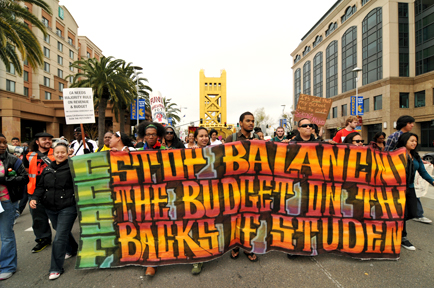Taking it to the capitol
Protesters blame budget process
By Greg Zeman
The Guardsman

Approximately 5,000 pro-education activists from across the state flooded the steps of the Capitol Building in Sacramento on March 22 to decry what they view as an apathetic state legislature.
“It’s time for us to show anyone who has ears to listen and eyes to see that higher education is a priority in California,” California State Student Association President Steve Dixon said. “We’re starting to lose things we can’t get back.”
According to the California Teacher’s Association, more than 23,000 educators have received pink slips since March 16.
Rigo Montalvo, a City College English tutor training to be a reading and English instructor, said he has seen the impact of teacher layoffs.
“As a tutor and a student I can see the problem,” Montalvo said. “Good teachers are losing their jobs, and when students can’t get an education, education is in crisis.”
City College students, some who rode chartered buses to Sacramento, participated in a march from Raley Field to the Capitol Mall. At the Capitol, a media conference was held to address the concerns of the crowd, including increased CC fees.
The Legislative Analyst Office, a California nonpartisan fiscal advisory group, recommended resident student fees raised to $40 per unit on Feb. 25. The office argued the most needy students already receive the Board of Governors Fee Waiver, and those who don’t could be reimbursed by new federal higher education tax credits, according to the LAO 2010-11 higher education budget report.
Jim Knudstrup, a City College student and President of the City College Veterans Alliance expressed frustration with the groups analysis.
“We can’t just take these cuts, because a lot of these temporary solutions, like budget cuts and layoffs, have a way of becoming permanent when people get too comfortable,” Knudstrup said. “It’s a creep, slowly diminishing our education, and it’s not going to stop at $40 — it might not stop at $100. Remember when it went up to $25, how outraged we all were? Here we are again.”
Some state assembly members addressed the crowd, including California Assembly Majority Leader Alberto Torrico.
“There is something terribly wrong. For the first time in California’s history, the state is spending more money on prisons than colleges,” Torrico said. “Sixty percent of inmates are functionally illiterate.”
Torrico said that the result of increased incarceration in California was a “total failure, moral and economic bankruptcy.”
“I hate to tell you, but the answer isn’t in that building,” said Assembly member Warren Furutani, motioning to the Capitol Building. “The answer is in your voice, in your activism, in putting something on the ballot to save higher education.”
One proposed solution is the California Democracy Act, which would remove California constitutional language requiring a two-thirds majority to approve a state budget.
“We’re one of only three states that take two-thirds to pass a state budget,” said Brady Reed, a member of the California School Employees Association soliciting signatures for a petition to put the act on the ballot.

Comments are closed.